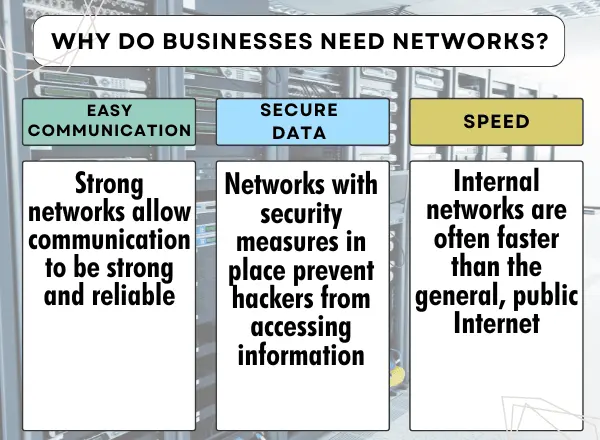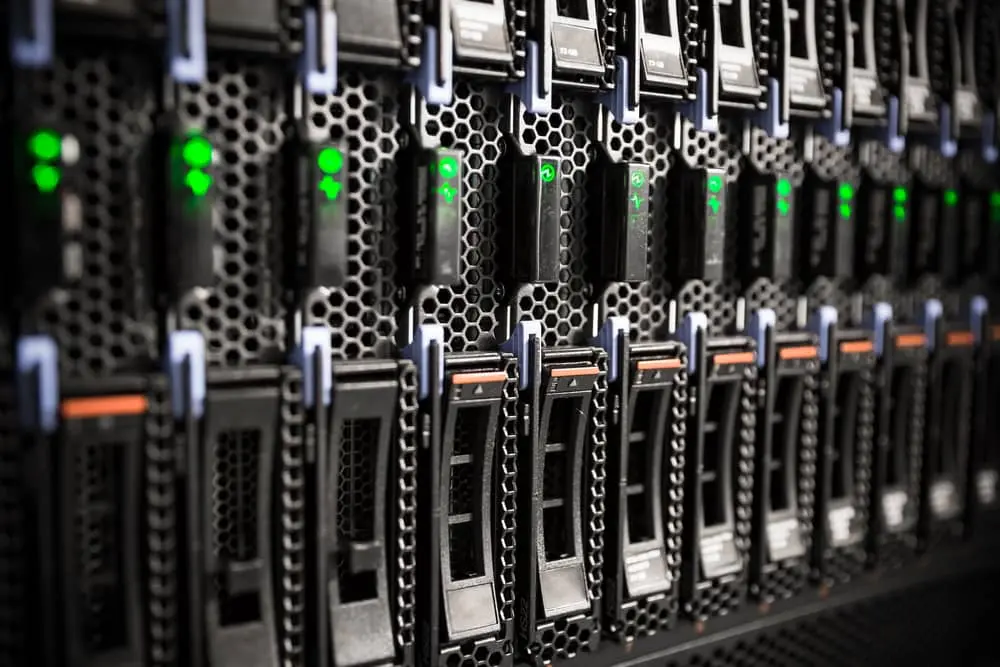Whether starting from scratch, looking to expand, or needing a new solution, choosing the right network to suit your business is vital. It ensures you can communicate easily with employees, keeps data secure, and allows your business to grow.
But what type of network should a small business use? When choosing the right network, the abundance of choices can be confusing.
That’s why our experts here at Down to Earth Technology have pulled together this comprehensive guide to help you make the right decision.
Why Do Businesses Need Networks?
A network is a group of computers and devices communicating and sending data between themselves. For businesses, this setup comes with a host of benefits:
Easy Communication

Communication is vital to business growth. One of the only ways to ensure productivity is for teams to easily discuss projects and deadlines. Strong networks allow communication to be strong and reliable.
Secure Data
All businesses have sensitive information that needs to be kept private, either within departments or inside the business. Networks with security measures in place can be encrypted and scrambled to prevent hackers from accessing information.
Speed
Internal networks are often faster than the general, public Internet. This means you can complete projects and finalize work more productively.
Computer networks can be classified by various properties, such as capacity, authorization, structure, technology, organizational purpose, etc. However, the most common network classification method is physical or geographical extent.
Here’s the list of the different types of computer networks:
- Local Area Network (LAN)
- Wide Area Network (WAN)
- Wireless Local Area Network (WLAN)
- Storage Area Network (SAN)
- Metropolitan Area Network (MAN)
Knowing these network types will help you determine which is right for your business needs. In the following sections, we will take an in-depth look at each type of network.
WHAT TYPE OF NETWORK SHOULD A SMALL BUSINESS USE?
WHAT IS LAN?
LAN means local area network and is the most common and popular network design in most businesses and homes. It is a network that interconnects devices in a limited geographical area. A LAN’s defining characteristic is connecting devices located within a single, limited area, such as a building or a house.
However, the scale or number of devices doesn’t limit a LAN. It can be large, such as an enterprise network with thousands of connected devices, or small, such as a home network with only a few devices.
A simple office LAN consists of cables, access points, switches, routers, etc., which connect devices such as computers and laptops with internal servers and printers but, more importantly, allow the connected devices to access a shared internet connection.
More robust LANs include firewalls, load balancers, network intrusion detection, redundant links, and traffic segregation, among other features.
The advantages of a LAN are that the connected devices can use a single Internet connection, share files, and use shared printers. But more importantly, the connected devices can be accessed, managed, and controlled from one location.
What is the Difference Between a Router and A Switch?
Just as a switch connects several devices to create a network, a router connects several switches and their respective networks to create an even larger network. These networks might be in a single location or across multiple locations. You’ll need one or more routers when building a small business network.
WHAT IS WAN?
WAN stands for wide area network. A wide area network is a huge computer network that connects groups of computers or communication devices over large distances. Unlike a LAN, it is not tied to a single geographic location.
WANs are generally used by businesses to connect their office networks located at multiple geographical sites. Each office typically has its own LAN, and these LANs are connected via a WAN.
Therefore, a WAN can be viewed as a collection of LANs or other communication networks. The largest and most common example of a WAN is the Internet. Compared to a LAN, a WAN requires additional hardware components.
Some essential hardware required for a wide area network are WAN switches, access servers, modems, routers, ISDN terminal adapters, ATM switches, and multiplexers.
The most common WAN technologies are:
LEASED LINES
A leased line indicates a direct network connection that you rent from a company, such as an internet service provider (ISP), that already has the infrastructure that you need. Since the leased lines are reserved exclusively for the leaseholder, you are assured of performance and bandwidth.
Because of the same reasons, it is an expensive option. How much you pay for the lease would depend on the distance between the connected networks and performance requirements.
SYNCHRONOUS OPTICAL NETWORK (SONET)
Synchronous optical networking is a standardized digital communication protocol that synchronously transmits large volumes of data over long distances using a fiber optic medium. It allows simultaneous voice, data, and video transmission at speeds as high as 1Gbps through a single fiber.

FRAME RELAY
Frame Relay is a WAN technology for transmitting data between LANs and over a WAN. This technology packages data into frames and sends it through a shared network.
Each frame contains all the necessary routing information to guarantee that it reaches the proper destination. It is simple to configure and less expensive than leased lines, which contributes to its popularity.
INTERNET PROTOCOL SUITE
The foundation of all modern networking is the Internet Protocol Suite. It is also known as TCP/IP, which stands for Transmission Control Protocol/Internet Protocol. The TCP/IP defines the addressing, identification, and routing specifications so that computers and other devices can communicate via the Internet.
Although most users may associate the Internet Protocol Suite solely with the Internet, the Internet indicates a network of networks; on the other hand, the Internet Protocol Suite is the unique set of protocols that governs the connection of devices and data transmission.
WHAT IS WLAN
WLAN stands for wireless local area network. As the name suggests, a WLAN forms a LAN by connecting devices using wireless communication, i.e., it doesn’t rely on wired Ethernet connections.
This means a lot less cabling is required, and your mobile devices won’t need to be tethered; therefore, they will be truly mobile. A WLAN can be an alternative to a wired network or an extension.
WLANs use high-frequency radio waves and usually include one or more access points, allowing users to move around within its coverage area. WLAN and Wi-Fi are often used interchangeably.
However, it is important to understand that Wi-Fi refers to the wireless connection that a device uses, while WLAN refers to the wireless network itself. The hardware for your office WLAN should subscribe to 802.11ac standard (Wi-Fi 5) or higher.
The 802.11ac standard gives your network a throughput of a minimum of 1 gigabit per second (1 Gbit/s), a speed that’s become a prerequisite for most modern offices.
Since the wireless signal from your wireless equipment is broadcast over an area, everybody in that area can share it. This poses potential security hazards, and you must take several precautions to keep your network secure.
The choice of a wireless network over a wired one is complicated. It requires careful evaluation of numerous factors, including scalability, security, ease of management, performance, and cost.
WHAT IS SAN?

SAN stands for storage area network. It is a specialized, high-speed network that gives block-level network access to storage. Storage area networks are generally used to access storage devices such that the storage appears locally attached.
In other words, SAN is a dedicated network or subnetwork that interconnects and shows shared pools of storage devices to numerous servers. SAN is often confused with network-attached storage (NAS). While both are network-based storage solutions, they work quite differently.
SANs are dedicated to storage devices typically not available through the LAN. This segregation of storage traffic from the rest of the LAN traffic improves performance and application availability.
In addition to the storage devices, a SAN is usually composed of hosts and switches interconnected using different topologies, protocols, and technologies. SANs improve your data protection and security and can also play an important role in your organization’s data backup and business continuity strategy.
WHAT IS MAN?
MAN stands for metropolitan area network. It is a large computer network that usually spans a vast geographical area and is used in large companies and university campuses.
For example, a campus area network (CAN) is a type of MAN. It links the various buildings, such as academic colleges or departments, libraries, student residence halls, etc., located on a university campus.
CHOOSING THE RIGHT TYPE OF NETWORK FOR YOUR BUSINESS

When designing a computer network for a business environment, you need to consider a wide variety of factors, including network traffic, performance, network security, redundancy, hardware, management, maintenance requirements, and costs.
However, an immediate and important factor you need to consider is the physical extent of your network. Whether your office occupies a section within a co-working space, an entire building floor, multiple floors within a building, or multiple locations across the country or the globe, each situation calls for a different network solution.
Do you need a network for your small business? We can help! Please reach out to us today!

